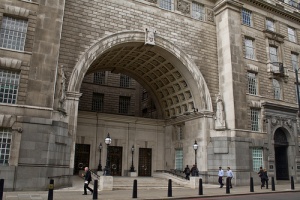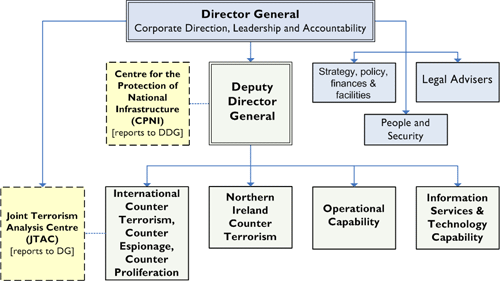Difference between revisions of "Security Service"
Tom Griffin (talk | contribs) (→Binyam Mohamed case) |
Tom Griffin (talk | contribs) (→Defunct Branches) |
||
| Line 95: | Line 95: | ||
*[[MI5 F Branch|F Branch]] - Domestic counter-subversion | *[[MI5 F Branch|F Branch]] - Domestic counter-subversion | ||
*[[MI5 K Branch|K Branch]] - counterespionage 1968-1994 | *[[MI5 K Branch|K Branch]] - counterespionage 1968-1994 | ||
| + | *[[MI5 S Branch|S Branch]] - Management services 1976-c.1994 | ||
===Related organisations=== | ===Related organisations=== | ||
Revision as of 17:32, 17 February 2015
The Security Service, better known as MI5, is the main British domestic intelligence service. (See also: Category:MI5)
History
During World War Two, MI5's Double Cross system effectively subverted espionage in Britain. In 2014 it emerged that MI5 had also gained effective control of a network of domestic Nazi sympathisers.[1]
Operation FOOT
In September 1971, MI5's Operation FOOT led to the mass expulsion of Soviet diplomats from London. The event would prove to be the high-point of the service's cold war counter-espionage role.[2]
Counter-Subversion and the "far and wide" left
Peter Wright describes a meeting of senior A Branch and MI5 F Branch officers to discuss the "far and wide left" early in Michael Hanley's tenure as head of MI5:
- The Prime Minister and Home Secretary had left him in no doubt that they wanted a major increase in effort on this target. He then handed over to a young and ambitious F Branch officer, David Ransome, who outlined the activities and structure of a host of left-wing splinter groups , like the Workers Revolutionary Party (WRP) and the Socialist Workers' Party (SWP).[3]
The Wilson Plots
There have been a number of allegations that MI5 officers plotted against Prime Minister Harold Wilson during his second term of office in the mid-1970s.[4]
Monitoring Prime Ministers
The Mail on Sunday reported in April 2010 that MI5 bugged Downing Street under five Prime Ministers between 1963 and 1977. The bugs were initally ordered by Prime Minister Harold Macmillan. After a brief gap they were reinstated by his successor, Alec Douglas-Home. It is not clear whether Edward Heath and Harold Wilson were told of the surveillance. Historian Stephen Dorril suggests this revelation appears to justify Wilson's belief that he was being spied on.[5]
The surveillance was ended on the orders of Prime Minister James Callaghan in 1977. Callaghan nevertheless denied in the Commons that No. 10 had ever been bugged.[6]
Details of the bugging were due to appear in Professor Christopher Andrew's 2009 official history of MI5, The Defence Of The Realm, but were removed at the insistence of the Cabinet Office.[7]
Vetting Ministers of State
Once a new Government has been formed MI5 briefs the incoming Prime Minister on any Ministerial appointments it thinks may be of concern to 'national security'. MI5's director general, Sir Stephen Lander told Radio 4: "In 1997 therefore the way the then cabinet secretary and I agreed we would deal with it... was that I would produce the summaries, one sheet for each of the individuals that we thought we should make a comment on... and if the prime minister said I'm thinking of making X secretary of state for defence, they [the cabinet secretary and the prime minister's principal private secretary] would say 'well prime minister, you might like to read this from the security service'." [8]
Binyam Mohamed case
In February 2010, the Security Service was sharply criticised in a draft judgement by the Master of the Rolls (head of the Court of Appeal) Lord Neuberger over its role in the case of Guantanamo detainee Binyam Mohamed:
- as the evidence in this case showed, at least some SyS officials appear to have a dubious record when it comes to human rights and coercive techniques, and indeed when it comes to frankness about the UK’s involvement with the mistreatment of Mr Mohammed by US officials. I have in mind in particular witness B, but it appears likely that there were others.[9]
Police corruption
The Mail reported in April 2014 that an MI5 unit had been set up to monitor corruption in the Metropolitan Police, following the murders of Daniel Morgan and Stephen Lawrence.[10]
Structure
Senior Management
Mark Hollingsworth and Nick Fielding give the following list of senior officers
- Director General (DG)
- Deputy Director General (DDG)
- Director and Co-ordinator of Intelligence (Northern Ireland)
- Legal Advisor to the Security Service[11]
Management Board
According to the MI5 website, the Director General, Deputy Director General and Legal Advisor make up the Management Board of the Service, along with seven branch Directors. The board is supplemented by two Non-Executive Directors from outside the Service in an advisory role.[12]
Branches
The following list is taken from the 2003 edition of Hollingsworth and Fielding's Defending the Realm: Inside MI5 and the War on Terrorism and may now be somewhat dated.[13] This is supplemented with branch descriptions from the MI5 website in italics where these seem to match Hollingsworth and Fielding's account.[14]
There are some differences between the two accounts. According to the website, international counter-terrorism and counter-espionage are the the responsibility of a single branch, suggesting that Hollingsworth and Fielding's D and G branches may have been merged or re-organised. The website also lists a separate Information Services and Technology Capability branch, suggesting that information technology may have been separated from H Branch.
- A Branch - Operational Support (Operational Capability)
- A1A: Technical Operations, such as covert entry and audio and video surveillance.
- A1F: As above, but on longer term target sites.
- A2A: intercept transcription.
- A3 and A5: Technical support for operations, including specialised covert photography and lockpickers.
- B Branch - Human Resources (People and Security)
- B1: Protective security for MI5 including building security and staff vetting.
- B2: Personnel.
- B7: Training and recruitment.
- D Branch - Non Terrorist Organisations
- D1: Vetting of non-MI5 personnel.
- D4: Counter-espionage. Targets include Russia and China.
- D5: D Branch agent runners.
- G Branch - International Terrorism (International Counter Terrorism, Counter Espionage, Counter Proliferation)
- G2P: Counter-proliferation
- G3A: C-ordination of threat assessments.
- G3C: Countering threats from South Asia, e.g. Sikh militants.
- G3W: International terrorist threats not covered by other sections.
- G6: G Branch agent runners.
- G9A: Libya, Iraq, Palestinian and Kurdish groups.
- G9B: Iranian state and Iranian dissident groups.
- G9C: Islamic extremists.
- H Branch - Corporate Affairs (strategy, policy, finance and facilities)
- H1 and H2: Liason with Whitehall, the police and the media, covert financial enquiries, management policy including information technology.
- H4: Finance.
- R2: Main Registry
- R5: Restricted 'Y-boxed' files.
- R10: Registry for temporary files.
- R20: Administers GCHQ material.
- T Branch - Irish Terrorism (Northern Ireland Counter Terrorism)
- T2A: Republican and loyalist terrorism in Great Britain.
- T2B: Liaison with local Special Branches and agent runners responsible for investigating Irish terrorism in Great Britain.
- T2C: Threat assessment for Irish terrorist groups.
- T2D: Researches Irish terrorist groups.
- T2E: Liaises with Metropolitan Police Special Branch, based at Scotland Yard.
- T5B: Investigates arms trafficking
- T5C: Counters Irish terrorism in Continental Europe, including the Republic of Ireland.
- T5D: Irish terrorism in the rest of the world.
- T5E: Studies terrorist logistics
- T8: T Branch agent-runners, includes a Northern Ireland-based section.[15]
Defunct Branches
- C Branch - Protective security
- E Branch - Empire and Commonwealth counter-subversion - 1953-1971
- F Branch - Domestic counter-subversion
- K Branch - counterespionage 1968-1994
- S Branch - Management services 1976-c.1994
Related organisations
People
Directors General
- Major-General Sir Vernon Kell - 1909-1940
- Brigadier Oswald Allen Harker - 1940-1941
- Sir David Petrie - 1941-1946
- Sir Percy Sillitoe - 1946-1953
- Sir Dick White - 1953-1956
- Sir Roger Hollis - 1956-1965
- Sir Martin Furnival Jones - 1965-1972
- Sir Michael Hanley - 1972-1978
- Sir Howard Smith - 1978-1981
- Sir John Jones - 1981-1985
- Sir Antony Duff - 1985-1987
- Sir Patrick Walker - 1987-1992
- Dame Stella Rimington - 1992-1996
- Sir Stephen Lander - 1996-2002
- Dame Eliza Manningham-Buller - 2002-2007 [16]
- Jonathan Evans - 2007[17]-2013
- Andrew Parker - 2013[18]-
External Resources
- The Report of the Detainee Inquiry, December 2013.
- Richard Norton-Taylor, The secret servants, The Guardian, 11 July 2009.
- Sam Leith, British Writers and MI5 Surveillance 1930-1960 by James Smith - Review, The Guardian, 7 March 2013.
Notes
- ↑ MI5 spy controlled UK Nazi group, files reveal, BBC News, 28 February 2014.
- ↑ Christopher Andrew, Defence of the Realm, The Authorized History of MI5, Allen Lane, 2009, p.565.
- ↑ Peter Wright, Spycatcher, Viking, 1987, p.360.
- ↑ Brian Wheeler, Wilson 'plot': The secret tapes, BBC News, 9 March 2006.
- ↑ Jason Lewis and Tom Harper, Revealed: How MI5 bugged 10 Downing Street, the Cabinet and at least five Prime Ministers for 15 YEARS, Mail on Sunday, 18 April 2010.
- ↑ Jason Lewis and Tom Harper, Revealed: How MI5 bugged 10 Downing Street, the Cabinet and at least five Prime Ministers for 15 YEARS, Mail on Sunday, 18 April 2010.
- ↑ Jason Lewis and Tom Harper, Revealed: How MI5 bugged 10 Downing Street, the Cabinet and at least five Prime Ministers for 15 YEARS, Mail on Sunday, 18 April 2010.
- ↑ Day One in Number Ten, BBC Radio 4 at 1100hrs BST on Friday, 14 May 2010.
- ↑ Binyam Mohamed case: full texts of Paragraph 168 - and how they changed, 26 February 2010.
- ↑ Richard Pendlebury and Stephen Wright, 'Bent cops' and a growing stench of corruption: The disturbing links between suspect officers and the gangster father of one of Stephen's killers, Daily Mail, 4 April 2014.
- ↑ Mark Hollingsworth and Nick Fielding, Defending the Realm: Inside MI5 and The War on Terrorism, André Deutsch, 2003, pp.320-321.
- ↑ Organisation, MI5, accessed 19 July 2009.
- ↑ Mark Hollingsworth and Nick Fielding, Defending the Realm: Inside MI5 and The War on Terrorism, André Deutsch, 2003, pp.320-321.
- ↑ Organisation, MI5, accessed 19 July 2009.
- ↑ Mark Hollingsworth and Nick Fielding, Defending the Realm: Inside MI5 and The War on Terrorism, André Deutsch, 2003, pp.320-321.
- ↑ MI5 - Former Directors General, accessed 26 February 2008.
- ↑ MI5 - Director General, accessed 26 February 2008.
- ↑ Andrew Parker named as new head of MI5, BBC News, 28 March 2013.

